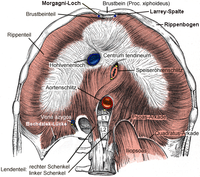
Photo from wikipedia
Background: congenital lumbar hernias are rare. It constitutes to 20% of all lumbar hernias which is less than 1.5% of all the abdominal wall hernias. There are no more than… Click to show full abstract
Background: congenital lumbar hernias are rare. It constitutes to 20% of all lumbar hernias which is less than 1.5% of all the abdominal wall hernias. There are no more than 50 cases reported in literature till date. We report a case of congenital lumbar hernia in a preterm female neonate located on the superior lumbar triangle. Case: a preterm female neonate was born, presented with a mass at the right lumbar area with a size of 8x8 cm, round, movable with bluish discoloration, well delineated border, no visible veins, increases in size when the patient cries, and reduces easily. Ultrasonography revealed a right posterolateral abdominal mass measuring 4.2x2.88x1.59 cm. CT scan revealed right posterolateral mid-abdominal wall hernia with protrusion and no intestinal obstruction. The patient underwent exploratory laparotomy, where hernia defect was about 2 cm in diameter in the right posterior abdominal wall, pararenal area, and just below the 12 rib. The ascending colon and parts of the ileum were adherent inside the hernia defect at the right lumbar area. Primary closure of the hernia defect was done by suturing the psoas major and the transversus abdominis and internal oblique muscles. The postoperative, patient had good bowel movement, no abdominal distention or vomiting. Feeding was then started and well tolerated. After two weeks follow-up, there were no signs or symptoms of intestinal obstruction such as nausea and vomiting. Patient is being fed regularly and passes bowel movement almost 2-3 times a day. Conclusion: appropriate diagnosis of the extent of the defect through the advent of CT scan and early detection of other congenital anomalies should be routine in these cases. Open surgery with primary repair is almost always done but we can consider laparoscopic approach in the future with uncomplicated lumbar hernias.
Journal Title: Journal of Biomedical Nanotechnology
Year Published: 2018
Link to full text (if available)
Share on Social Media: Sign Up to like & get
recommendations!